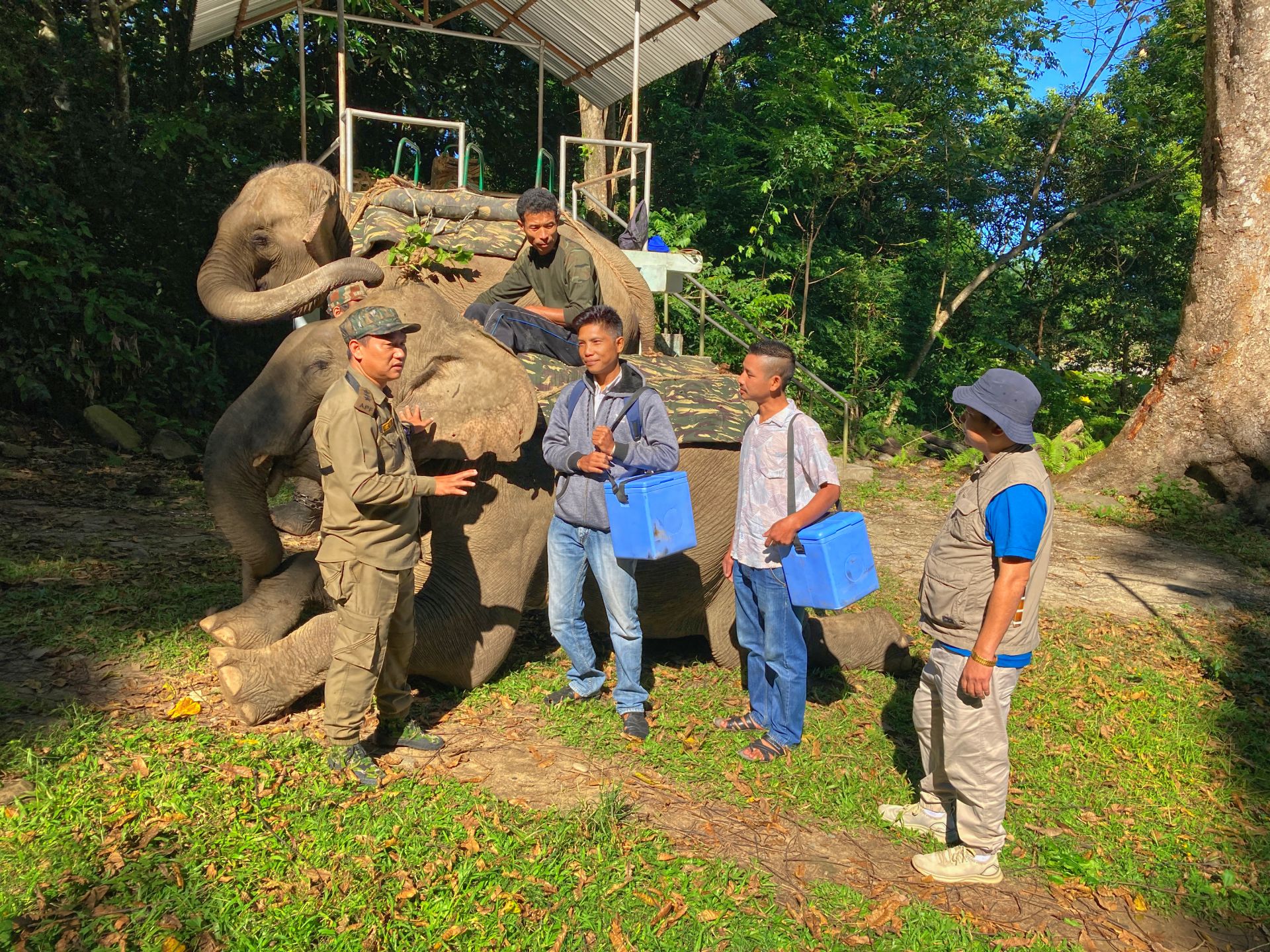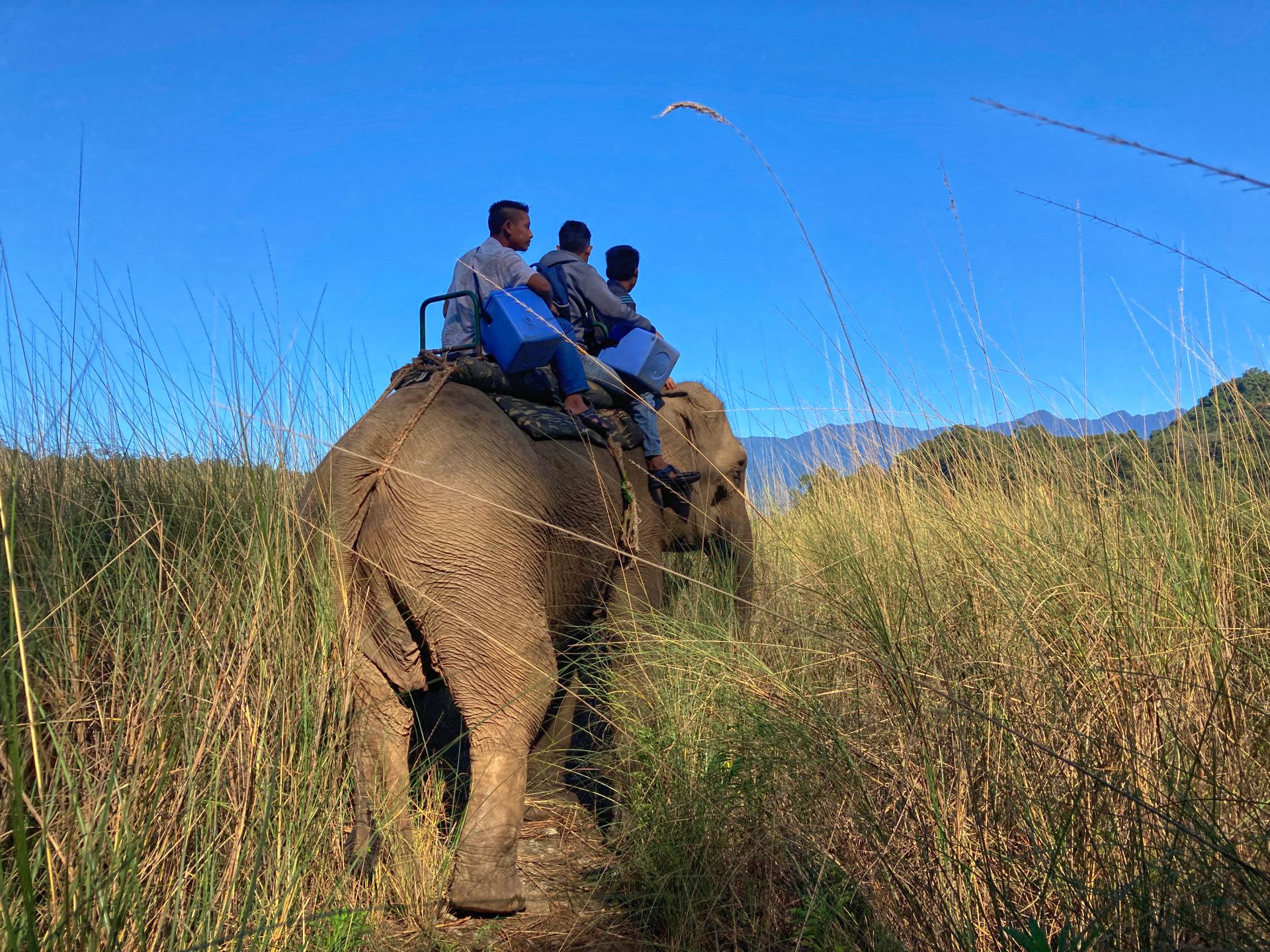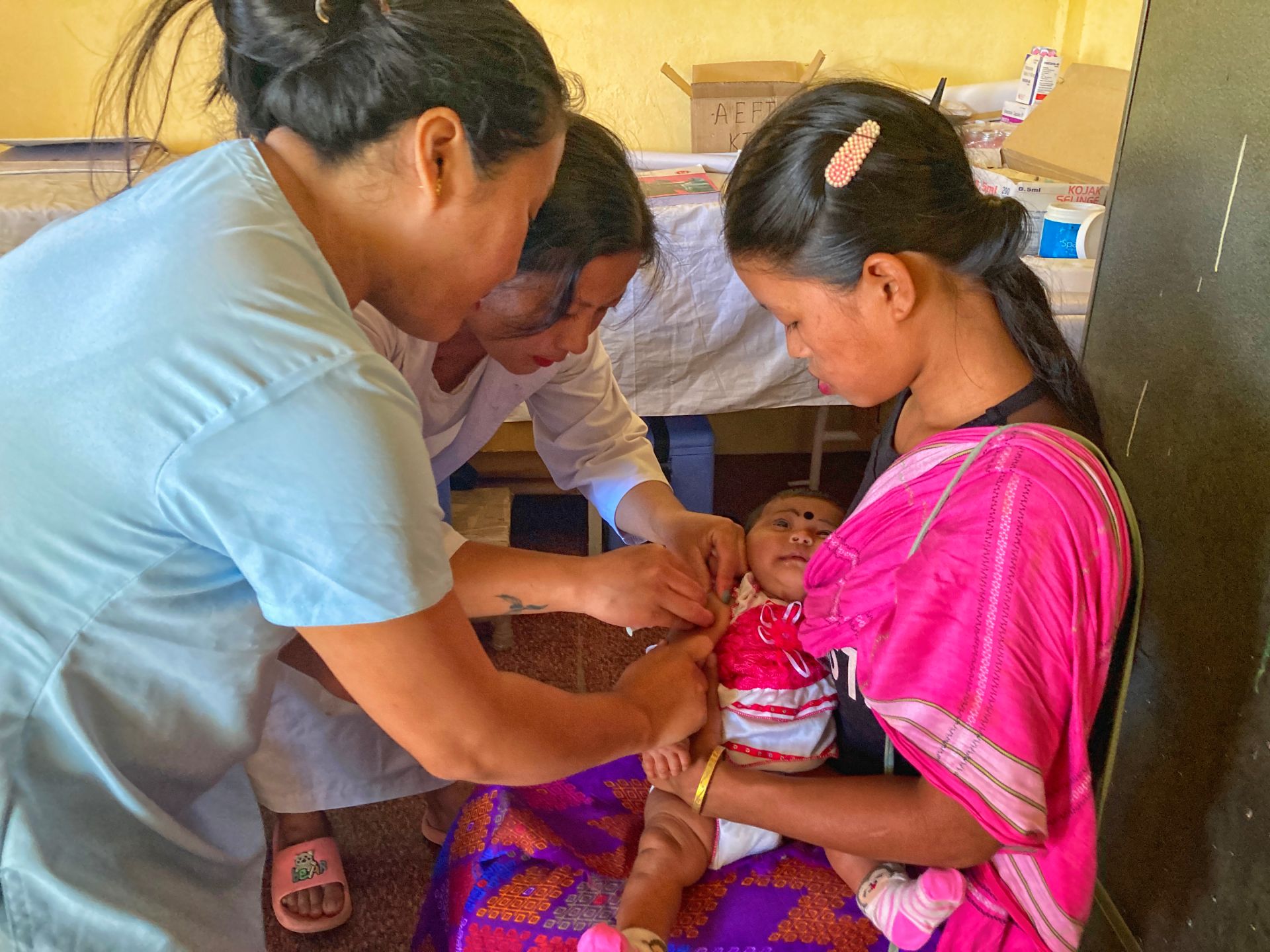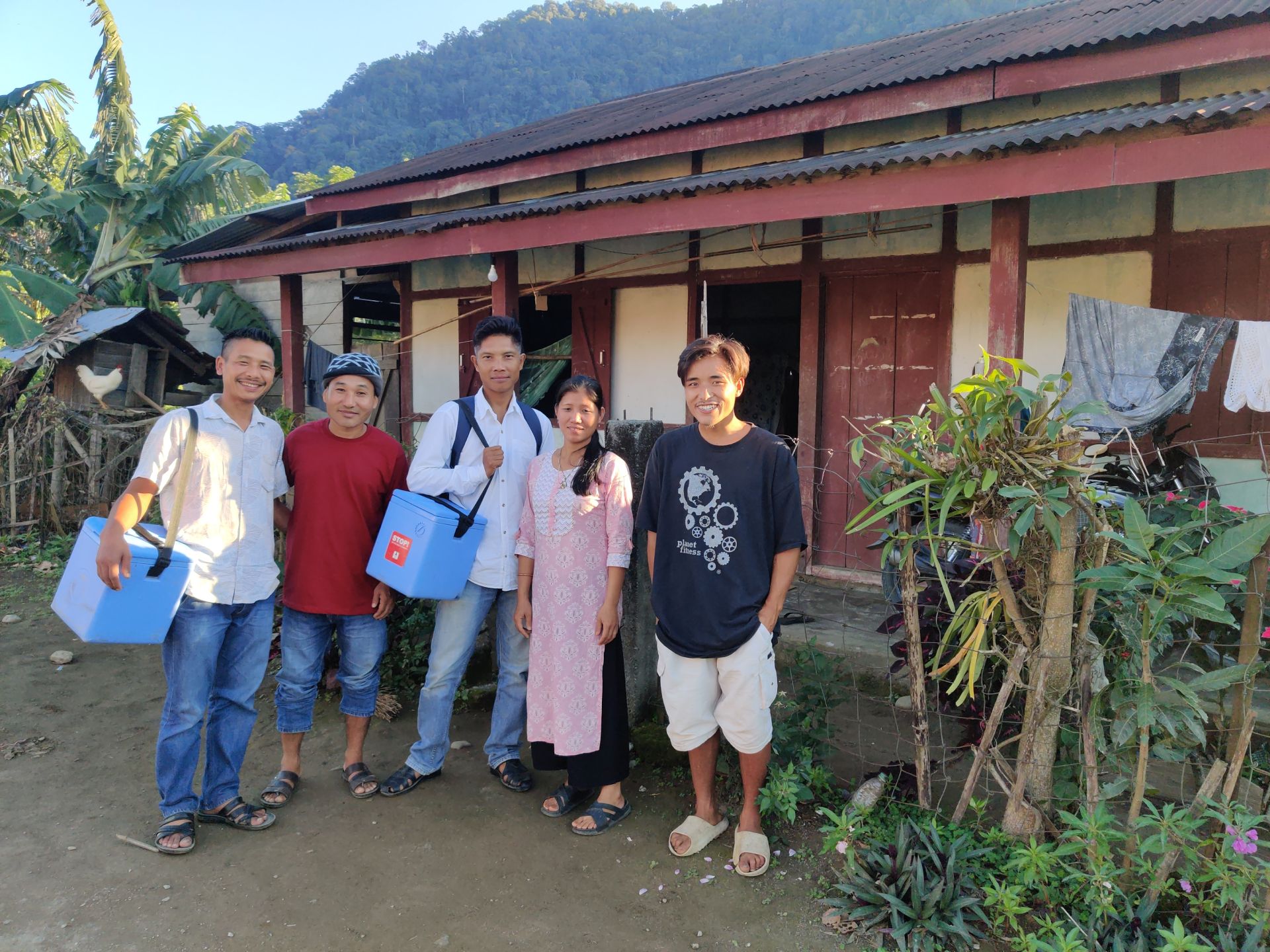When the undercurrents in the Noa-Dihing river turn treacherous, Lakhi, 36, mother of two healthy elephants, steps up to carry vaccinators and lifesaving vaccines to protect human children living across the river in hard-to-reach hamlets in the Changlang district of Arunachal Pradesh.
Delivering vaccines on elephants, rowboats and drones is part of alternative vaccine delivery microplanning for routine immunization in the Changlang district bordering Myanmar. Lakhi’s support to routine immunization activities in the district is made possible through a collaboration between the Department of Health in the Miao sub-division in Changlang district and the Department of Environment and Forest, Namdapha National Park and Tiger Reserve, which is her home.

Mr Tage Mali (extreme left), forest officer, Miao circle, Namdapha National Park and Tiger Reserve, and Dr Jongsam Handsome (extreme right), medical officer in-charge, Miao sub-division, Changlang district, brief vaccinators before they begin their elephant ride across the river to Ayushman Bharat Health & Wellness Centre Deban. The elephant Lakhi sits patiently with her nephew Samraj, 13, who is getting ready to head off for forest patrolling. (Photo: Sanchita Sharma / © WHO India)
“Communities live in isolated and remote areas here, so when medical teams arrive to supply medicines and services to far-flung villages, the wildlife department helps them in every possible way. We provide resources, manpower and logistics support, such as boats and elephants to help the medical teams reach remote villages, and manpower and logistics help to carry supplies,” said Mr Tage Mali, forest officer, Miao circle, Namdapha National Park and Tiger Reserve. “Forest elephants – we have eight – also carry food rations and medicines to areas cut-off during floods, and in routine patrolling and protection activities, including carrying rations and personnel to remote anti-poaching camps,” he said.

Lakhi carries lifesaving vaccines through Namdapha National Park and Tiger Reserve and across the Noa-Dihing to Ab-HWC Deban in the Changlang district of Arunachal Pradesh. (Photo: Sanchita Sharma / © WHO India)
For immunization to save lives, quality vaccines must reach beneficiaries on schedule for timely vaccination. “The challenge in Miao district is that all terrain is difficult and we have to ensure that all vaccines reach session sites in time from the cold-chain point in Miao. Elephants are particularly useful for planning for routine immunization sessions and health outreach drives to remote during the monsoon months (June to September), when the river overflows and the roads get waterlogged,” said Dr Jongsam Handsome, medical officer in-charge, Miao sub-division, Changlang district, Arunachal Pradesh.

The vaccinators get off the elephant across the river, from where the vaccinators hike to Ayushman Bharat Health & Wellness Centre Deban situated 2 km away (Photo: Sanchita Sharma / © WHO India)
The elephant drops off the vaccinators across the river amid high elephant grass, from where the vaccinators hike with vaccine carrier bags weighing 5 kg to Ayushman Bharat Health & Wellness Centre Deban (AB-HWC) situated 2 km away. The hike takes them over bamboo bridges, elephant grass and woodland to reach in Buddisatta village, which is home to 20 families with a population of 93. “The AB-HWC opened 10 years ago and changed the life of our community. With electricity, tap water in every home, and a new BSNL (telecommunication tower) increasing network connectivity, our troubles are 95% solved. The vaccines and education – a new building is being built for Deban Middle School for children from here and neighbouring Nandankanan, Punyabhumi and Anandapur-II villages – are what our children need for a healthy and prosperous future,” said Mr Kingong Wangi, village headman, Lama village.

Lakhi and her elephant attendant Mr Sumit Gogoi and mahout (elephant driver) Mr Ganesh Tamang head home after a job well done (Photo: Sanchita Sharma / © WHO India)
The vaccinators were accompanied by the WHO National Public Health Support Network (NPSN) team, which is providing technical and monitoring support for routine immunization and vaccine-preventable diseases to the Government of Arunachal Pradesh with special focus on strengthening services in hard-to-reach areas. Under the Government of India’s Universal Immunization Programme, close to 2.67 crore children and 2.9 crore pregnant women are immunized free of cost against 12 vaccine-preventable disease annually.

A WHO National Public Health Support Network field team from Namsai district accompanies district health officers and forest personnel to the Lama village to provide monitoring support (Photo: Sanchita Sharma / © WHO India)
The AB-HWC Deban serves 929 households with a population of 4936. “We have three ASHA for 10 villages. To ensure that no child is missed, ASHA workers go house-to-house before an immunization session to urge mothers to get their children immunized at the AB-HWC Deban on the scheduled day,” said Ms Bobita Chakma, ASHA. “The closest Community Health Centre is three hours away in Wakru, so when ASHA didi (sister) tells me about the immunization session, I make time to bring my daughter Purani for immunization,” said Ms Ruby Chakma.

Ms Ruby Chakma (sitting, in pink and blue) nursing her baby as she waits with other mothers and children for her turn at AB-HWC Deban (Photo: Sanchita Sharma / © WHO India)
To increase institutional deliveries, the health department has procured an ambulance to bring pregnant women and the sick to the Community Health Centre and District Hospital. “We are in the process of hiring a driver for the ambulance, the ambulance service should be operational by the end of 2023,” said Dr Handsome.

Ms Roma Chakma getting her daughter Twisha Chakma vaccinated. (Photo: Sanchita Sharma / © WHO India)
“There are 13 children on the ‘due list’ for vaccination today, but more have come because mothers of children who have missed receiving scheduled vaccines at neighbouring AB-HWCs have also brought their children here. Vaccine hesitancy is very low in this region, if parents fail to come, it’s because they cannot get away from the field or have other young children to care for,” said ANM Ms Rokon Ronrang. While women usually accompany newborns and babies, children over 2 years often come with their fathers on bikes.

At the end of the day, Lama village headman Mr Kingong Wangi (second from left) and link worker Ms Leela Chakma (second from right) say goodbye to the vaccination team before they head home to Miao. (Photo: Sanchita Sharma / © WHO India)
At the national level, vaccines are provided against nine diseases – diphtheria, pertussis, tetanus, polio, measles, rubella, severe form of childhood tuberculosis, hepatitis B, and meningitis and pneumonia caused by haemophilus influenza type B. Vaccination against rotavirus diarrhoea and pneumococcal pneumonia are provided in some states and are currently in the process of being scaled up to cover the entire country, while Japanese Encephalitis vaccine is provided to children in endemic districts.
